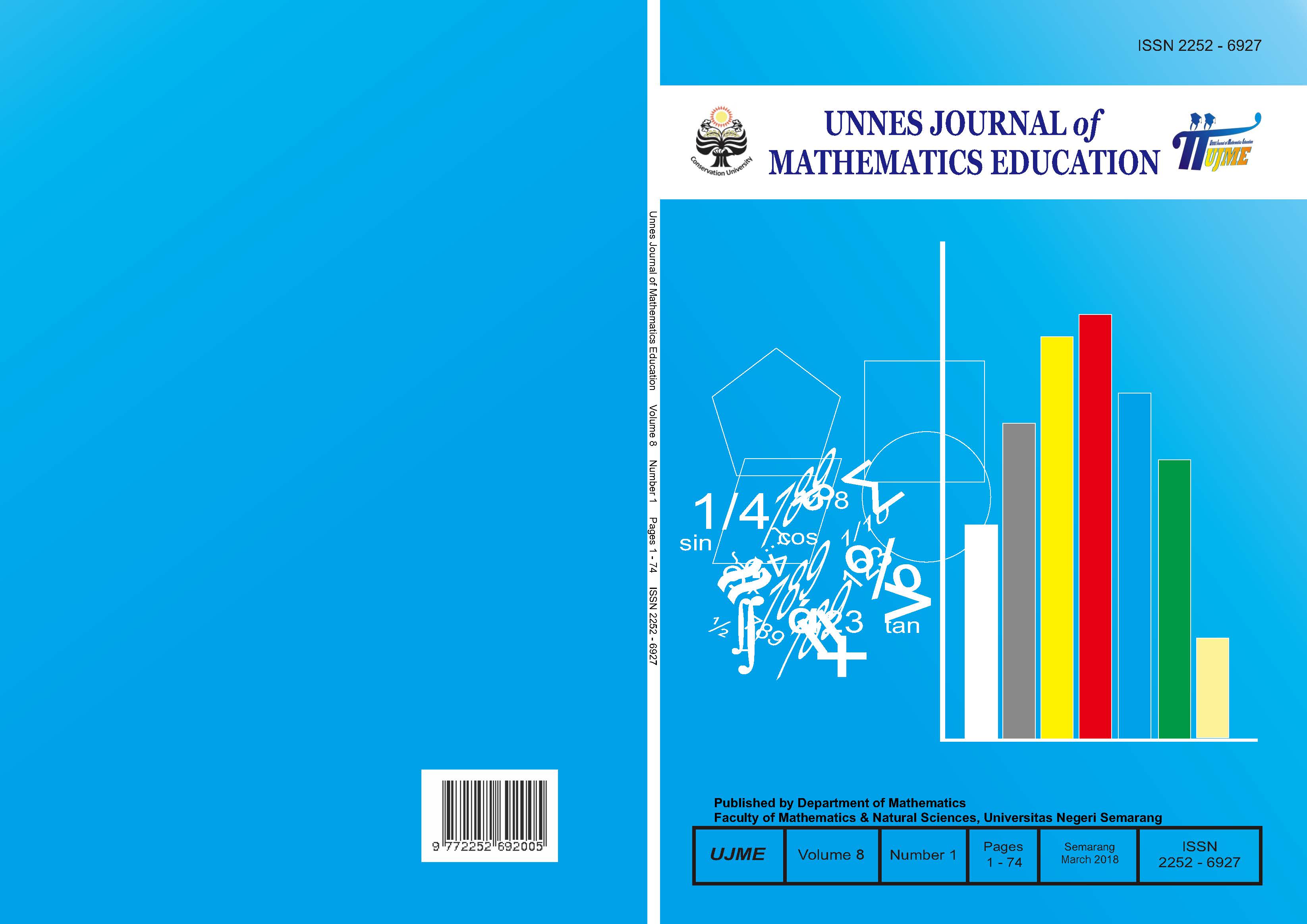Mathematical creative thinking ability based on students’ characteristics of thinking style through selective problem solving learning model with ethnomatematics nuanced
##plugins.themes.academic_pro.article.main##
Abstract
This study aimed to determine the effectiveness of the Selective Problem Solving (SPS) model with ethnomatematics nuances on students' mathematical creative thinking abilities and describe mathematical creative thinking abilities based on students' characteristics of thinking style by applying Selective Problem Solving model with ethnomatematics nuances. The study population were VII grade students one of Junior High School in Magelang in the academic year of 2017/2018. The study sample were students of class VII B with Selective Problem Solving learning model with ethnomatematics nuances and students of class VII G with Problem Based Learning (PBL) model. They were chosen through cluster random sampling technique. Quantitative data were analyzed using normality, homogeneity, proportion test, independent sample t-test, and paired sample t-test. Qualitative data were analyzed using data validation, data transcript, reduction, data presentation, and conclusions. The results showed that students 'mathematical creative thinking ability in Selective Problem Solving learning model with ethnomatematics nuances has not yet reached classical completeness, students' mathematical creative thinking ability in Selective Problem Solving learning model with ethnomatematics nuances was better than students' mathematical creative thinking ability in Problem Based Learning (PBL) model, there were differences of students interest on local culture before and after learning in Selective Problem Solving learning model with ethnomatematics nuances, sequential concrete thinking type, namely subjects fulfilled the indicator of fluency and the indicator of flexibility and were enough in fulfilling the indicator of novelty, sequential abstract thinking type showed that subjects fulfilled the indicator of fluency and less fulfilled the indicator of flexibility and novelty, random abstract thinking type revealed that subjects less fulfilled the indicator of fluency and not fulfill the indicator of flexibility and novelty, and random concrete thinking type showed that subjects less fulfilled the indicator of fluency and flexibility and did not fulfill the indicator of novelty.
##plugins.themes.academic_pro.article.details##
References
De Porter, B. & Hernacki, M. (2003). Quantum Learning: Membiasakan Belajar Nyaman dan Menyenangkan. Bandung: Kaifa.
Fajriyah, E. (2018). Peran Etnomatematika Terkait Konsep Matematika dalam Mendukung Literasi. Prisma, Prosiding Seminar Nasional Matematika, 1, 114-119.
Hudojo, H. (2003). Pengembangan Kurikulum dan Pembelajaran Matematika. Surabaya: UM Press.
Khoiri, W., Rochmad, & Cahyono A.N. (2013). Problem Based Learning Berbantuan Multimedia dalam Pembelajaran Matematika untuk Meningkatkan Kemampuan Berpikir Kreatif. Unnes Journal of Mathematics Education. 2(1): 114-121.
Lestanti, M. M., Isnarto, & Supriyono. (2016). Analisis Kemampuan Pemecahan Masalah Ditinjau dari Karakteristik Cara Berpikir Siswa dalam Problem Based Learning. Unnes Journal of Mathematics Education, 5(1):18.
Munandar, U. (2012). Pengembangan Kreativitas Anak Berbakat. Jakarta: Rineka Cipta.
Ogunkunle, R. A., & George, N. R. (2015). Integrating Ethnomatematics Into Secondary School Mathematics Curriculum For Effective Artisan Creative Skill Development. European scientiffic Journal. 11(3): 386-397.
Purnomo, D. J., Asikin, M., & Junaedi, I. (2015). Tingkat Berpikir Kreatif pada Geometri Siswa Kelas VII Ditinjau dari Gaya Kogniti dalam Setting Problem Based Learning. Unnes Journal of Mathematics Education. 4(2): 10-18.
Riana, R., Suhito & Supriyono. (2017). Analisis Kemampuan Koneksi Matematis pada Pembelajaran Geometri Ditinjau dari Karakter Cara Berpikir Peserta Didik dengan Model CORE. Unnes Journal of Mathematics Education. 6(2): 1-10.
Rubio, J. S. (2016). The ethnomatematics of the Kabihug tribe in Jose Panganiban, Camarines Norte, Philippines. Malaysian Journal of Mathematics Science. 10: 211-231.
Sak, U. (2011). Selective Problem Solving (SPS): A Model for Teaching Creative Problem-Solving. Gifted Education International, Vol 27:349-357.
Silver,E.A.(1997). Fostering Creativity through Instruction Rich in Mathematical Problem Solving and Problem Posing. Zentralblatt fur Didaktik der Education.
Sirate, F.S. (2012). Implementasi Etnomatematika dalam Pembelajaran Matematika pada Jenjang Pendidikan Sekolah Dasar. Lentera Pendidikan. 15(1): 41-54.
Suherman, E. (2003). Strategi Pembelajaran Matematika Kontemporer. Jakarta : JICA Universitas Pendidikan Indonesia.
Sunandar, M. A., Zaenuri, & Dwidayati, N. K. (2018). Mathematics Problem Solving Ability of Vocational School Students On Problem Based Learning Model Nuanced Ethnomatematics Reviewed From Adversity Quotient. . Unnes Journal of Mathematics Education Research. 7(1): 1-8.
Wahyuni, A., Tias, A. A. W., & Sani, B. (2013). Peran Etnomatematika dalam Membangun Karakter Bangsa. Makalah Seminar Nasional Matematika dan Pendidikan Matematika. Yogyakarta : UNY.
Yosopranata, D., Zaenuri, & Mashuri. (2018). Mathematical Connection Ability on Creative Problem Solving with Ethnomathematics Nuance Learning Model. Unnes Journal of Mathematical Education. 7(2): 108-113.
